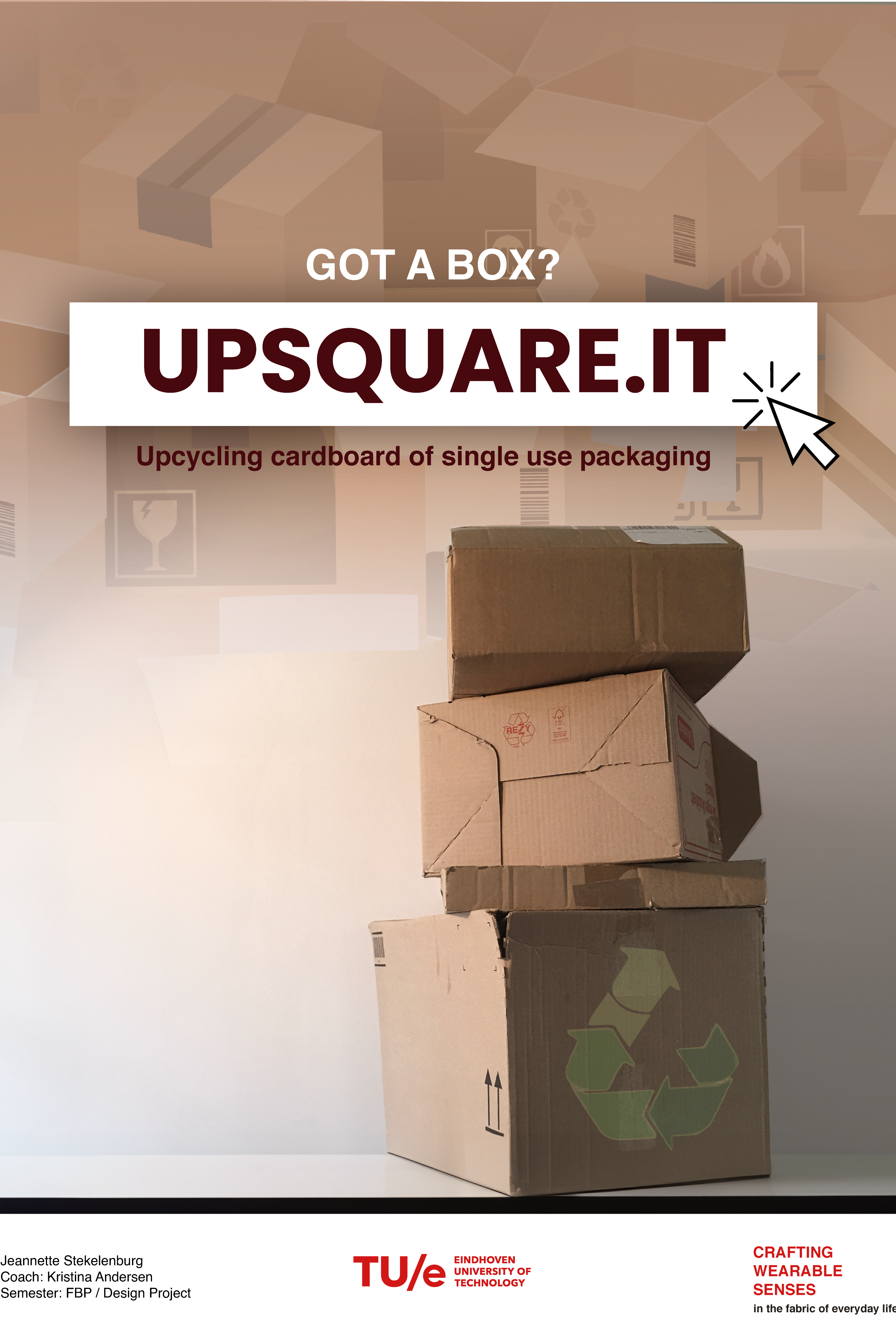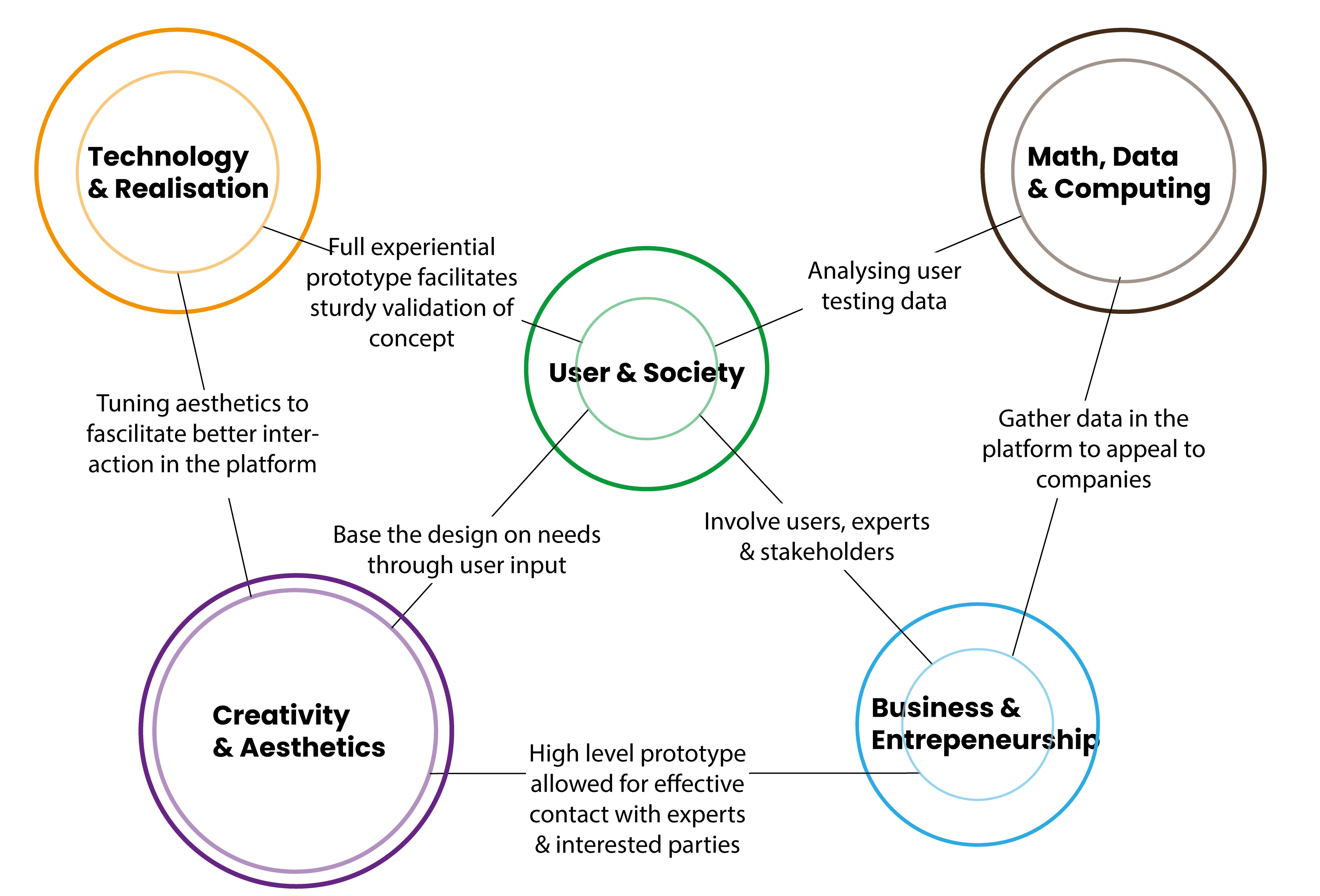UPSQUARE.IT
Final Bachelor Project by Jeannette Stekelenburg
Taking Cardboard towards a new Utility
Ever thought about how much boxes there are send and thrashed on a yearly basis? Or is your cardboard piling up in a corner?
UPSQUARE.IT offers a platform for (temporary) solutions to upcycle your cardboard boxes. With templates and easy to follow instructions, you can give your boxes a new use.
The platform is a direct response to challenge companies and individuals to rethink the purpose of single use packaging. The idea was to create an opportunity: to solve the problem of stacking boxes, unused materials and the waste of 84 million kilograms of produced cardboard yearly in the Netherlands in a functional manner.

For my FBP, I wanted to combine my expertise in software and design as well as my vision to create something that would overcome a daily struggle. Based on my own experience, I came up with the idea: could I reuse the cardboard envelope I received in the mail to make a clothing hanger instead of buying one? By surprise, my health made this project more of a challenge as I had hoped, resulting in the waste of a complete quartile at the start of the process. Fortunately, I was able to continue with designing thanks to the support from the faculty and the Wearable Senses squad. Ultimately this created a strange design process structure, as it did reduce the Demoday feedback to just the final one, but I was able to continue with the work after the 4th quartile. Now, I can proudly present the result of weeks in research and designing: a working prototype, several designs for upcycling cardboard and a lot of fundamentals to develop it even further onwards.
For me, the most difficult aspect of this project was mediating between my enthusiasm and making sure it would stay a realistic project within the timeframe I had to work with.
The first ideas laid emphasis on fully developing the platform, using it for a while and getting results from it. This was eventually reduced to only creating it after research and ideation, creating a more realistic design scope. This also made sure I focused more on my development as a designer instead of an software engineer. In the figure on the right, an overview of expertise area development is visualized. The centre circle represents where the skill was before this project, and the larger circle shows the percentual growth in this area.

— Business & Entrepreneurship, Creativity & Aesthetics, User & Society
This was the second time focussing on a product for the market and developing my business skills. Earlier work for my B2.1 project MEEBA helped starting up this project. Knowing for which market I could make the platform beneficial while weighing the needs of users (B&E and U&S), I even came into contact with potential collaborators and experts in the field of packaging. The high-quality finish of the online platform and prototypes (C&A) helped me create a realistic outlook on the platform’s potentials, convincing these parties to take the project seriously and help driving the project forwards. This helped me gather valuable expert input and defined the direction of the eventual product.
— Technology & Realisation, Math, Data & Computing
As described in my Professional Identity, I value the making of fully operational prototypes. To achieve this, I invested a great deal of time and effort into understanding and learning about HTML programming (T&R). As I never done that before, I also learned on this journey to implement CSS and JavaScript (T&R). The Aesthetics of Interaction course I took in my second year also gave me valuable insights here while developing the cardboard designs. In order to appeal to businesses, the feature to gather user data was implemented to collect numbers when users specifically use a company’s packaging for upcycling, eliminating the extended producer responsibility of said company that delivered them (MD&C).
— Creativity & Aesthetics, Technology & Realisation, User & Society
Most importantly, I wanted to go beyond what was expected of me in terms of user compatibility, investing a lot of time and research efforts to understand the target market and their needs. I created a house style that would fit the brand identity, making it as inviting as possible to set the platform apart (C&A). This was then afterwards implemented in the prototype (C&A/T&R). The main goal of this was to improve the user experience during use of the platform, which was also provided via the more in-depth feedback discovered during research (U&S).
This FBP has taken me on a journey to develop as a Research Designer and in aiming for realistic goals.
- I discovered that through setbacks, I still had persistence to achieve my goals. However, it was hard to set goals that were realistic. Even though I knew I had to do less because of time constraints, I initially wanted to accomplish more than would have been possible. It was very late in the process for me to realize that, and I think I would have benefitted to shape my end-goal earlier on. I now know that you can always do more after that is done!
- When working alone, you start to realize how pivotal external reviews become. Missing a lot in the start of my design process, I got a majority of the best insights through others in a later stadium of my work. I want to avoid that in a next project.
- I learned to define research better. As my focus never have been so much on user research, I have been confronted with how many things are necessary for a product to test. The importance of it is now evident, and will also help me forward in future projects.
After receiving much interest during Demoday, it has become clear to me that this idea does have potential to be developed much further. I hope to still get in contact with interested parties to continue working on the ideas or the platform. I think it could be a valuable asset in the upcoming years regarding the implementation of upcycling cardboard. So far, it has learned me a lot about design, myself and my goals and skills, and I hope it will continue to do so.